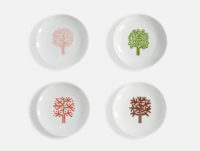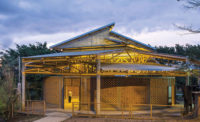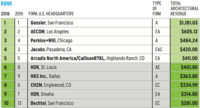The city of Columbus, Indiana, isn’t just one of the most architecturally-rich places in the United States—it’s also among the most overlooked. Where else can one find works by Eliel and Eero Saarinen, Cesar Pelli, Richard Meier, Kevin Roche, and I.M. Pei, all in thirty square miles? Landmark Columbus, a new preservation group established last year, has been working to elevate the city’s cultural status through the first annual Exhibit Columbus—an “exploration of architecture, art, design, and community” that kicked off September 29.
Home to fewer than 50,000 people but more than eighty works of Modern art and architecture, Columbus boasts upwards of a dozen buildings on the National Register of Historic Places. But despite its impressive Modernist past, construction on new projects in Columbus slowed in the 2000s as population growth plateaued. Exhibit Columbus hopes to inspire bold innovation and forward-thinking new development.
The exhibit will alternate between symposium and exhibition years, and this weekend’s inaugural symposium will serve as the launch event for the first J. Irwin and Xenia S. Miller Prize—a juried competition to select 10 finalists who will design site-specific installations for one of Columbus’s five most famous buildings. Those installations will be unveiled and opened to the public next August during the inaugural exhibition. According to Exhibit Columbus organizer Richard McCoy, the events are “a creative and affordable way to continue the conversation” around the city’s Modernist masterpieces, and part of Landmark Columbus’s commitment to what he calls “progressive preservation efforts.”
The prize is named for the couple whose generosity is in large part responsible for the city’s architectural patrimony. J. Irwin Miller, longtime chairman of the Columbus-based engine manufacturer Cummins, struck a deal with the city government in the late1950s that persists today: he would pay all the architects’ fees for public building projects if he could select the architect. Though the Millers have passed away and their descendants have left town, McCoy says the couple’s patronage helped shape a community that is still very much invested in preserving and celebrating the city’s unique landmarks.
In addition to showcasing Miller Prize finalists’ past work, this weekend’s symposium will include panels and discussions featuring Robert A.M. Stern, Deborah Berke, and Michael van Valkenberg, all of whom designed early projects in the Columbus area.
“We said, should we start small and build big? No, let’s start as big as we can,” says McCoy. “We looked at things like Prospect New Orleans and the Chicago Architecture Biennial, but we didn’t want to just create another biennial. We wanted to create something unique, for a unique place and keep pushing forward the value of good design.”
The three-day Exhibit Columbus symposium concludes on Saturday, October 1.







Post a comment to this article
Report Abusive Comment